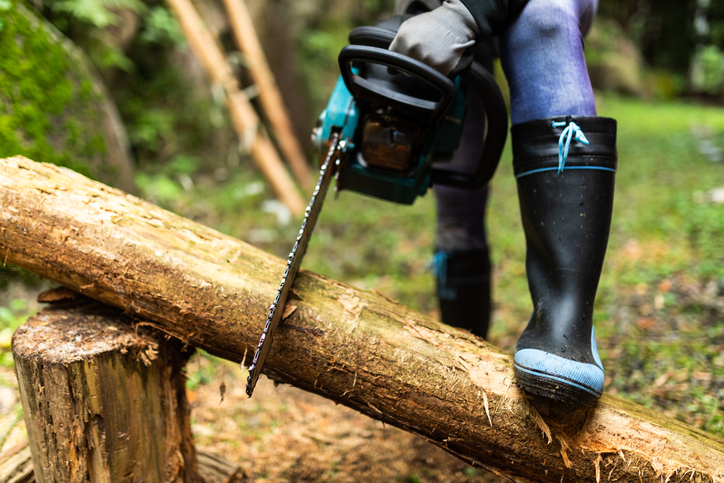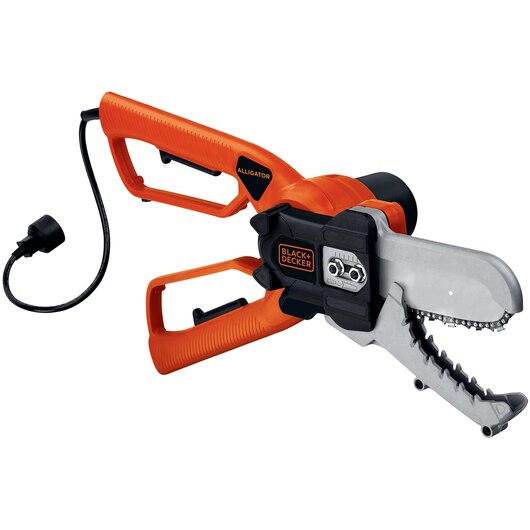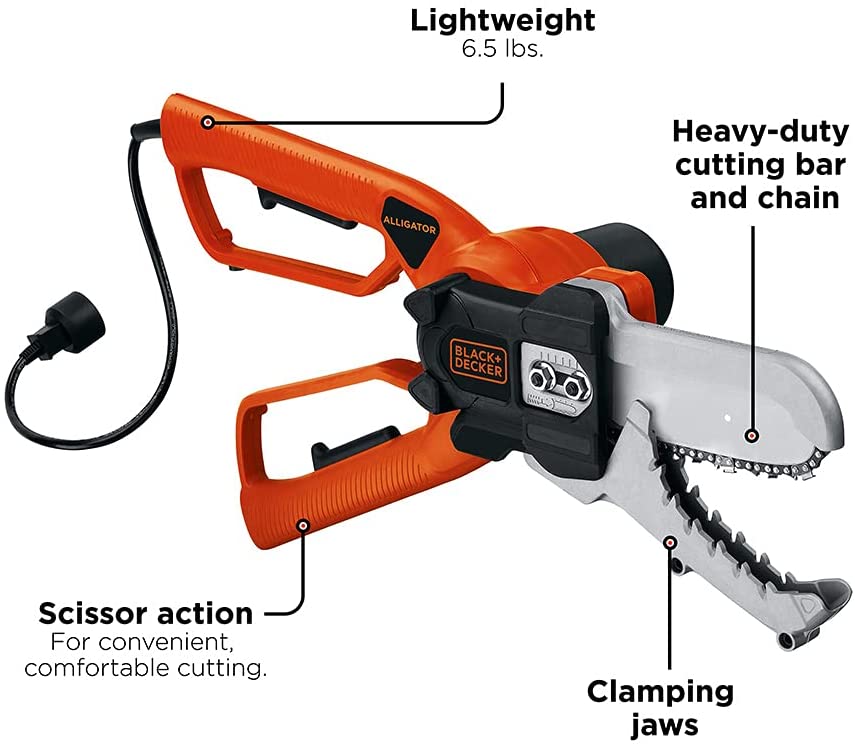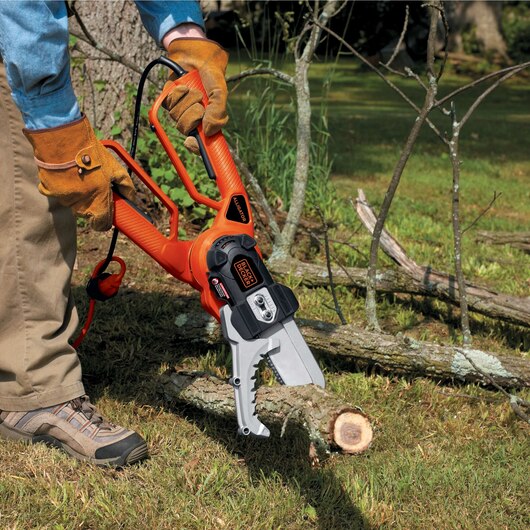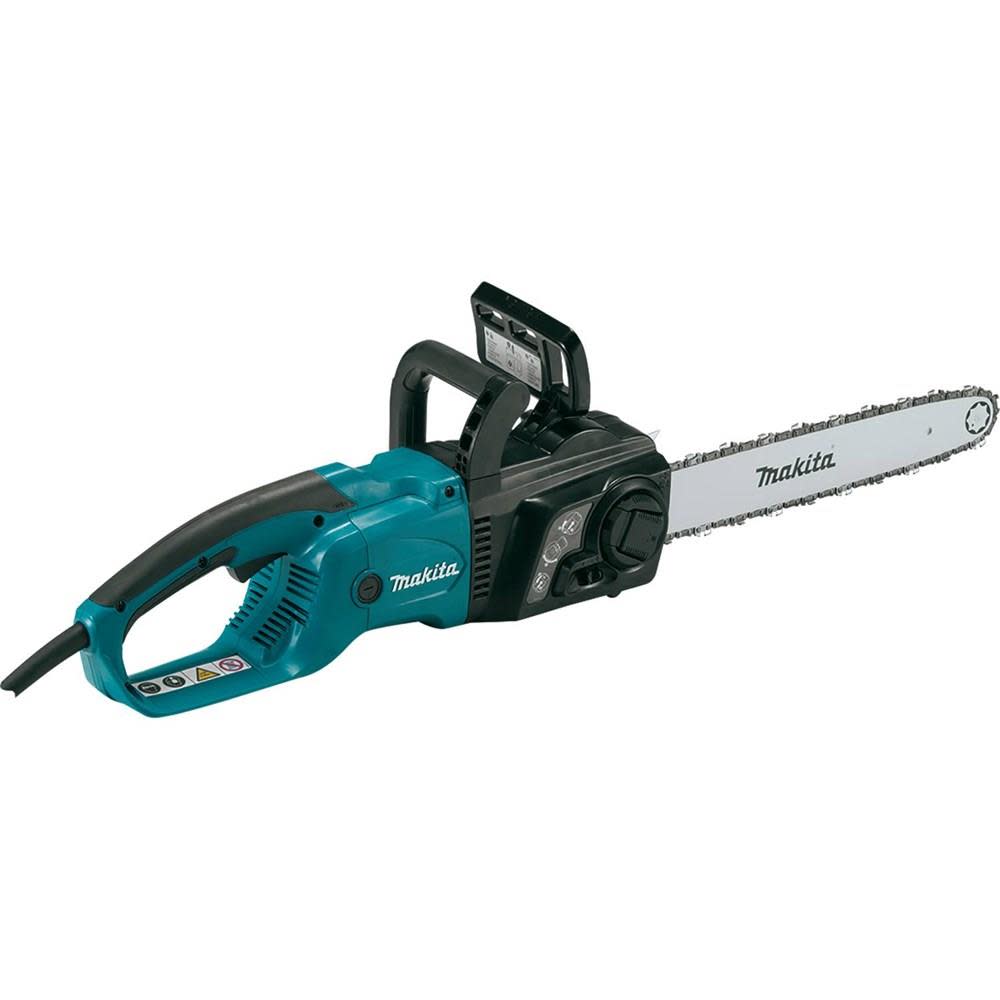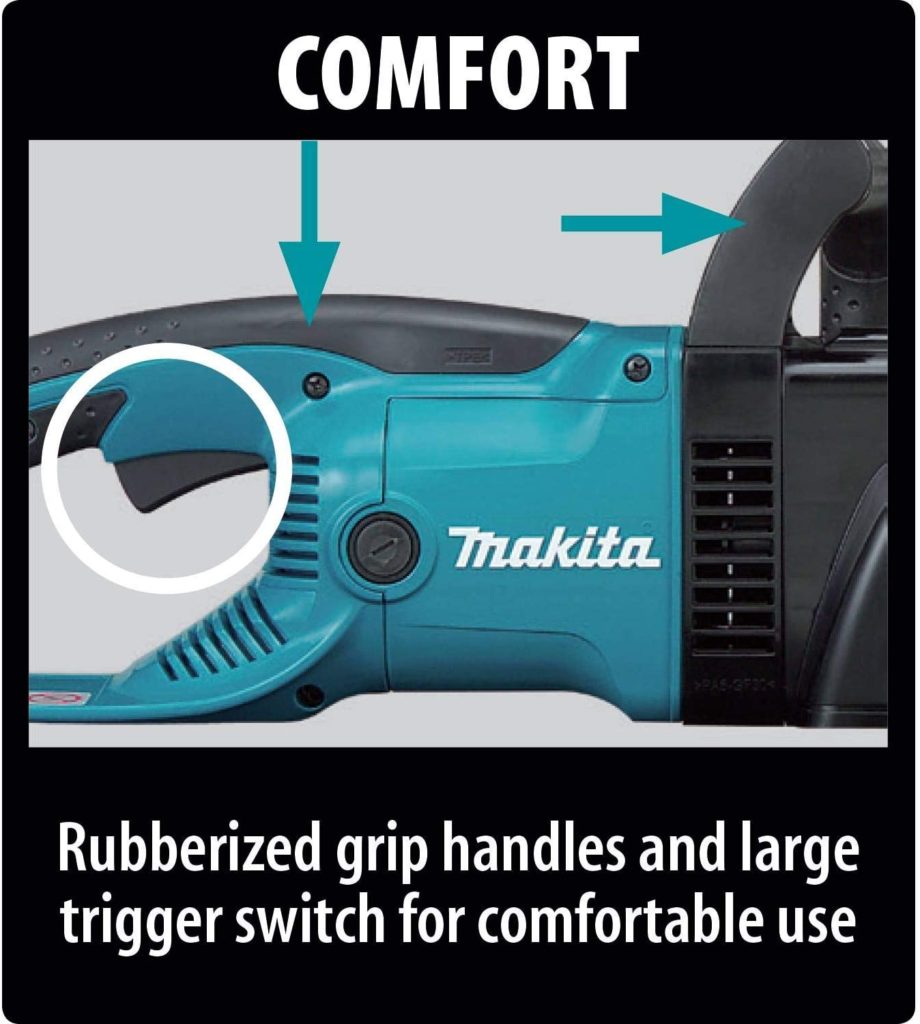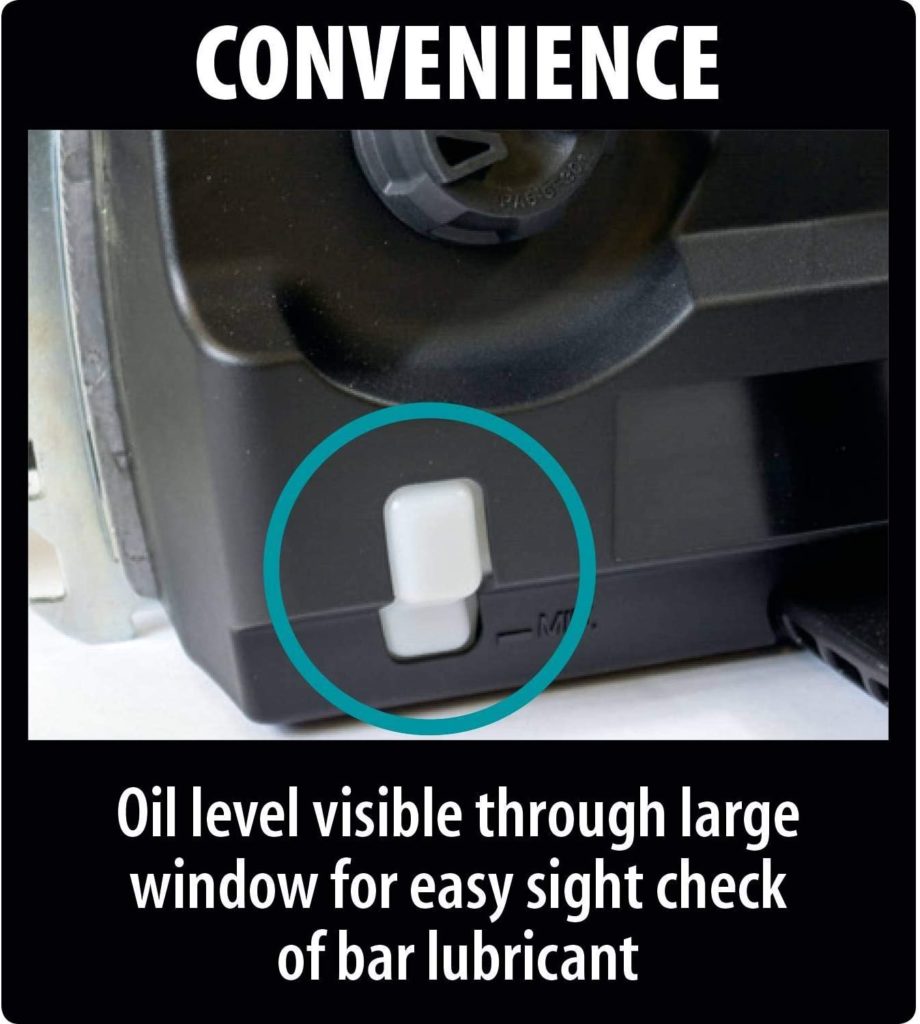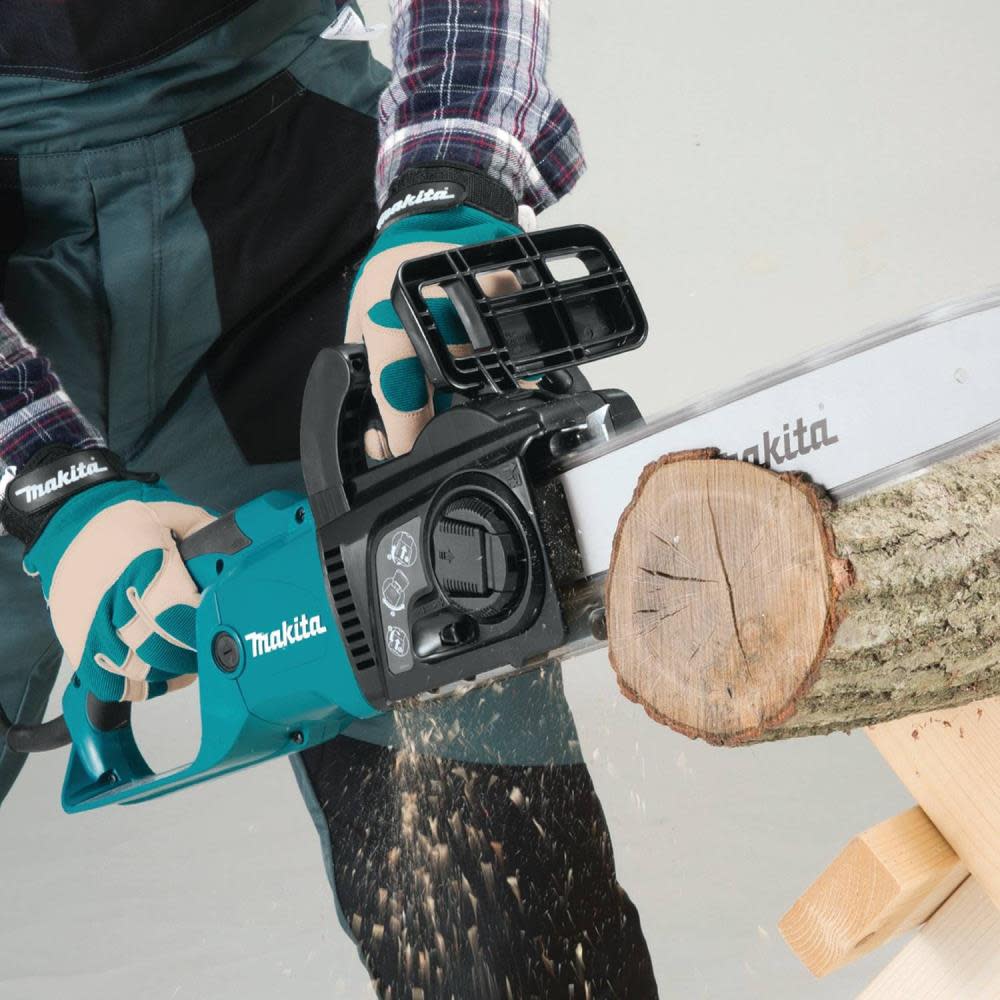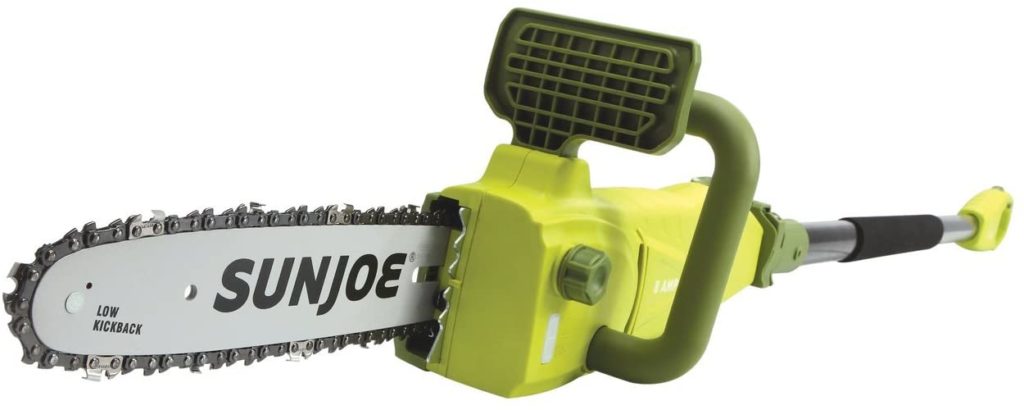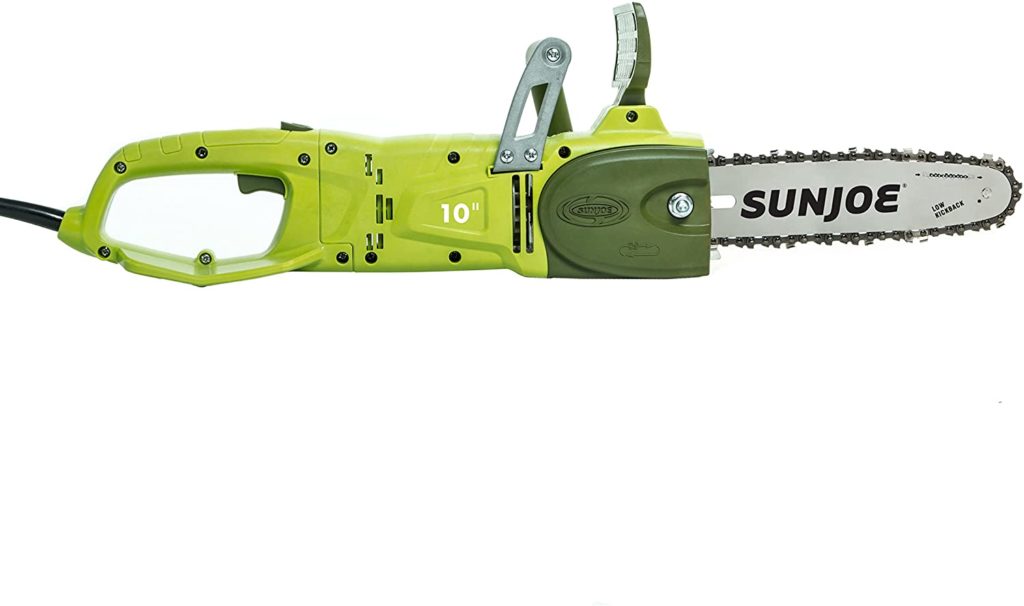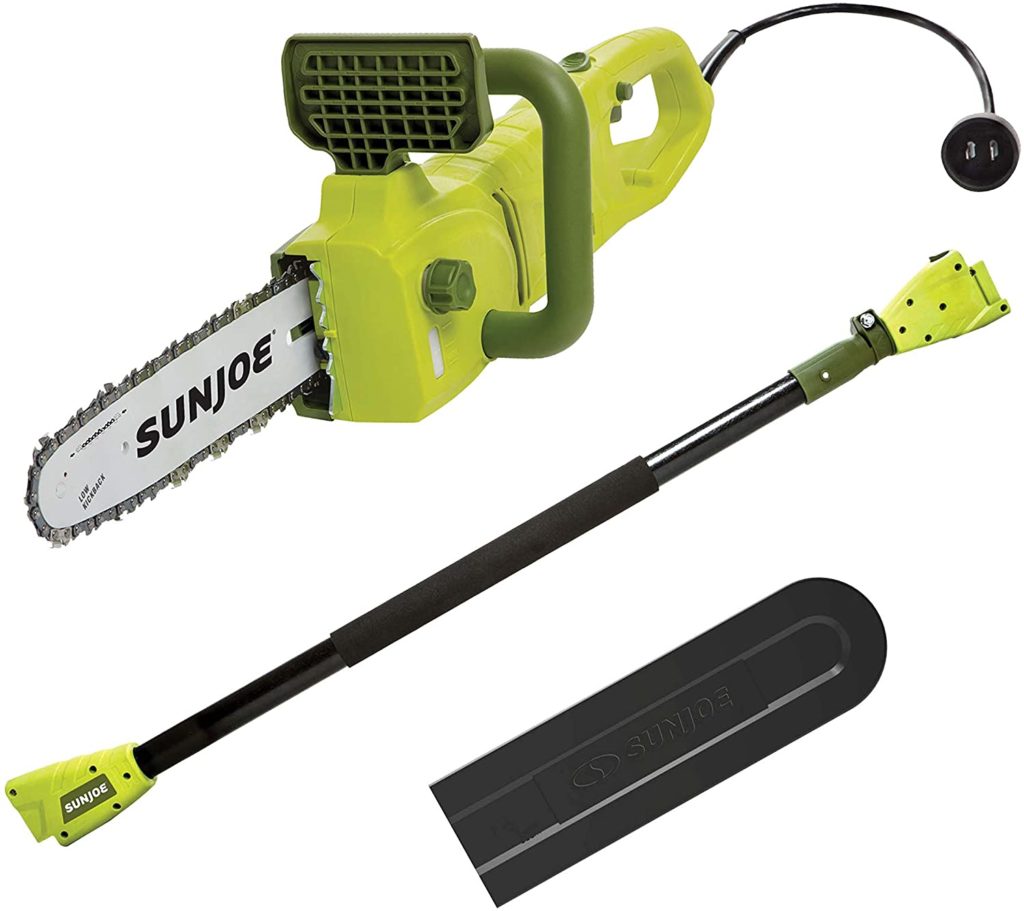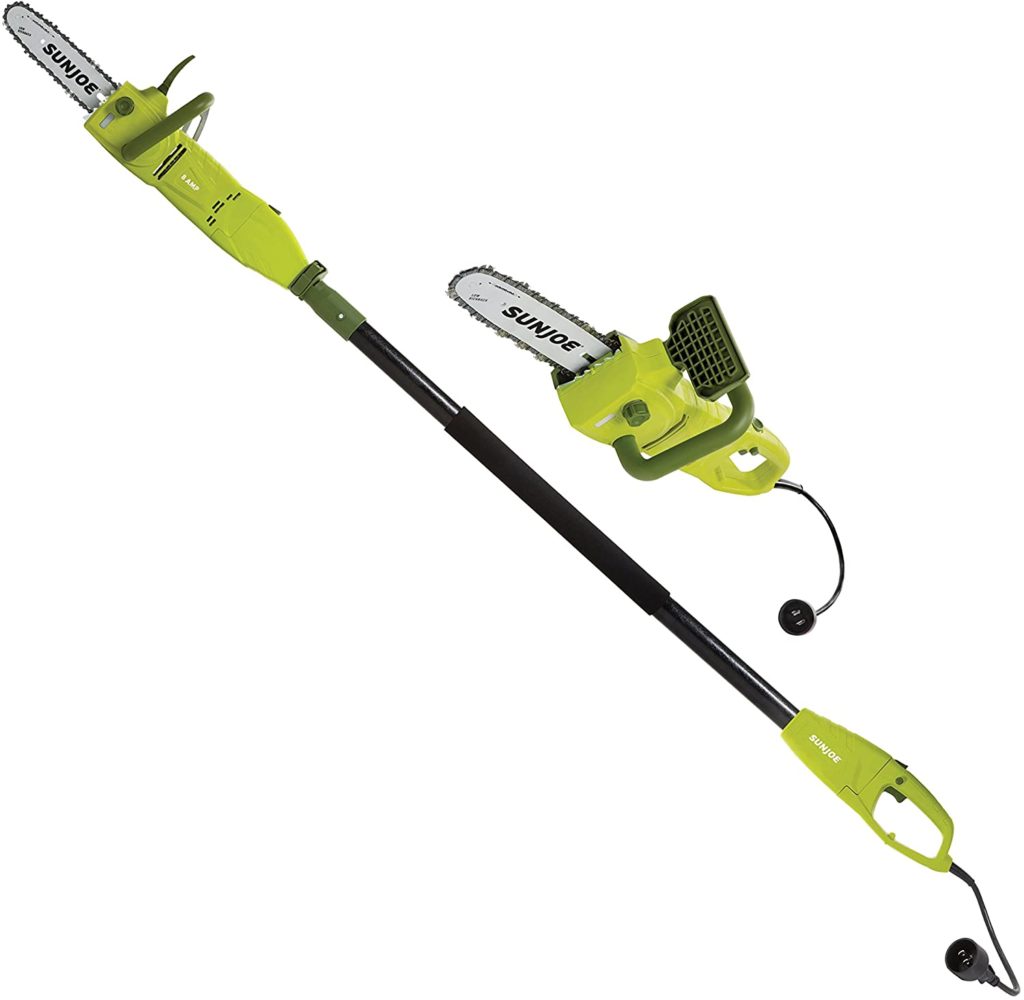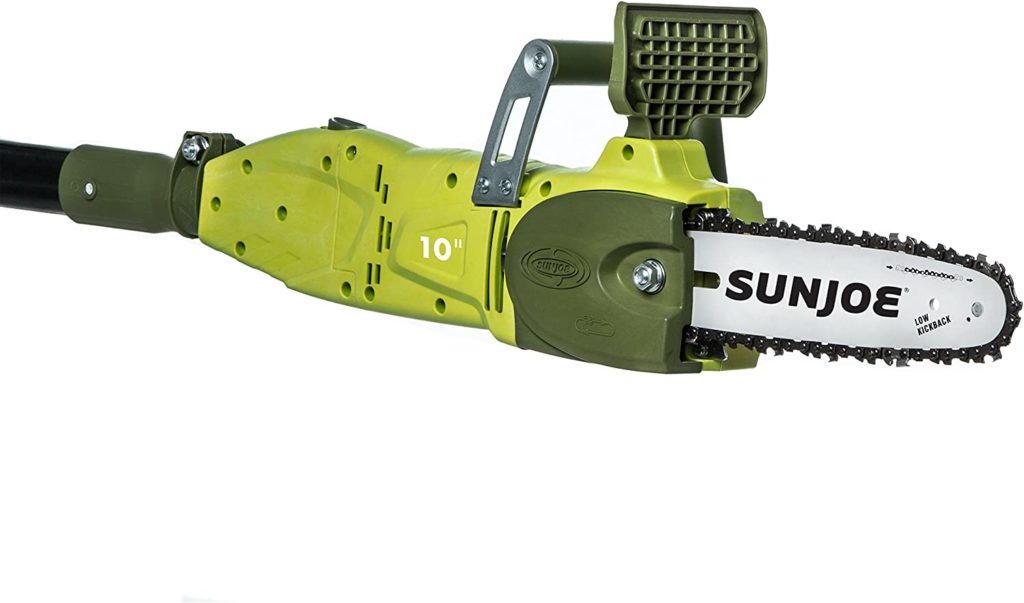If you need a budget-friendly chainsaw for cutting medium to large-sized trees, consider buying a corded electric chainsaw. Unlike their cordless cousins, these beasts can handle heavy-duty work. They’re also much more cost-effective and eco-friendly than gas-powered models.
However, getting the best corded electric chainsaw is easier said than done. It’s hard to tell which chainsaw is best for your project when so many types and brands are on the market.
That’s why we’ve written this comprehensive guide. Read on to learn more about corded electric chainsaws and how you can use one. Along the way, we’ll cover the advantages and disadvantages and offer three corded chainsaw reviews. You’ll know how to pick the best saw for your workbench by the end of this guide.
What Is a Corded Electric Chainsaw?
As its name suggests, a cordless electric chainsaw runs on outlet energy. Since they don’t use batteries, they need to be plugged in at all times.
Many people prefer corded electric chainsaws because they are more powerful, durable, and reliable than cordless battery-operated options. They’re also more eco-friendly, less smelly, and easier to maintain than gas-powered chainsaws.
Like cordless saws, corded chainsaws tend to be smaller than gas-powered saws. While gas-powered saws can have guide bars up to 48″ in length, electric corded saws tend to have bars 18″ and under. Accordingly, they’re best for simple jobs like cutting small branches and light storm cleanup. However, some corded models rival gas saws of the same length.
How Do You Use a Corded Chainsaw?
Corded saws are one of the easiest power tools to use and maintain. Here’s a step-by-step guide for using a corded electric chainsaw.
Locate a Nearby Outlet
First, you need to locate a nearby outlet.
Use an Extension Cord or Two
Next, plug in the extension cord. If the closest outlet is too far from your workbench, use an extra extension cord or two. Make sure you have enough arm and legroom to move and rotate your chainsaw.
Link Cords to Power Chainsaw
Link the extension cord(s) to your power chainsaw. Remember, your chainsaw needs to be connected to a power source to work.
Utilize Built-In Cord Retention To Manage Lines
Next, use your chainsaw’s built-in cord retention to manage lines. If your chainsaw doesn’t have a cord retention device, buy one. These devices prevent accidental disconnection and keep cord connections safe and clean.
Begin Wood Cutting With Instant Start Capability
Once everything’s plugged in and the cord retention device is in place, press Start. You’re now ready to begin cutting.
Advantages of a Corded Design Chainsaw
As previously explored, corded design chainsaws offer many advantages, including power, budget, and eco-friendliness. Let’s look at the main benefits of using a corded electric chainsaw.
Save Money on Refills Using a Chainsaw Without Gas
Unlike their gas-powered and cordless electric cousins, corded electric chainsaws don’t require gas refills or battery changes. They just need to be connected to an outlet. As such, you can work as long as you have electricity.
Cleaner Energy Compared to a Gas-Powered Engine
Corded electric chainsaws are more sustainable than gas-powered engines. Since they run on electricity, they don’t use fossil fuels or produce carbon emissions. They also produce less noise pollution because they tend to be quieter.
Typically Less Expensive Than a Gas-Powered Model
Corded models also tend to be less expensive than gas-powered models. Most gas-powered models are in the $200 to $300 range, while most corded electric saws are in the $100 to $200 range. You can even find highly recommended corded saws for less than $100.
Lightweight Design With an Electric Motor
Electric corded saws are popular because they’re lightweight and easy to move around. Unlike gas chainsaws and cordless saws, they only have electric motors to add to their weight. In contrast, gas chainsaws have fuel tanks, and cordless saws have lithium-ion batteries.
On average, gas and battery-powered chainsaws weigh around 12 to 16 and 10 to 12 pounds, respectively. In comparison, electric corded saws weigh about 6 to 12 pounds.
Limitless Runtime
Finally, electric corded saws offer limitless runtime. As long as the saw’s plugged in, you can cut as many blocks, branches, and trees as needed.
Disadvantages of Using a Corded Chainsaw
Although corded electric chainsaws provide many benefits, they also have some drawbacks. These include:
Less Powerful and Efficient When Clearing Tree Limbs
Despite technological advances, gas-powered models are still the go-to choice for clearing tree limbs. Unlike corded chainsaws, gas saws can quickly saw through limbs and large trees. Some can even cut through masonry and concrete.
Confined to Cord Length
Corded chainsaws are tethered to cords, giving you less space to twist and move as you cut through wood. Cords also make it challenging to work in tight places like corners.
Cords Can Inconveniently Get in the Way
If you don’t use cable protectors to organize and protect your cords properly, they can easily become tripping hazards for customers, employees, and clients alike. This can lead to severe injuries, lawsuits, and damage to your reputation.
Top Corded Chainsaw Models
Now that you know the advantages and disadvantages of corded electric models let’s look at the top three corded chainsaw models of 2022.
BLACK+DECKER LP1000 4.5-Amp Corded Electric Alligator Lopper Chainsaw
The BLACK+DECKER LP1000 4.5-Amp Corded Electric Alligator® Lopper Chainsaw is sleek and powerful, making cutting logs and branches effortless. Powered by a formidable 4.5-amp motor, this 6.5-pound model provides fast, precise cutting. Use its clamping jaws to grab and cut in one simple motion.
| Specification | Value |
|---|---|
| Power Type | Electric |
| Cord Type | Corded |
| Bar/Chain Length | 6″ |
| Engine Displacement/Equivalent Performance | 4.5A |
| Weight | 6.5 lbs |
| Certifications | UL Listed |
| Warranty | 2-years |
With a 6″ bar and chain, this baby is ideal for pruning branches up to 4″ in diameter. It’s also great for cutting branches into manageable pieces and cleaning up branches after storms.
This product has metal guards to cover the jaws from the cutting chain. Its tool-free chain adjustment also lets you adjust the chain without tools.
Every purchase of this product comes with:
- A BLACK+DECKER LP1000 4.5-Amp Corded Electric Alligator® Lopper Chainsaw
- An oil bottle
- A wrench
Here’s what customers are saying about this saw:
Pros
- Electric-powered
- Eco-friendly
- Lightweight
- Perfect for small woodcutting jobs
- Reaches tight spaces, unlike regular chainsaws
Cons
- Not for heavy-duty jobs
- Can’t cut wood thicker than 4″
- Chain frequently pops off
- Clogs quickly with wood pieces and chips
- Tool-free chain adjustment doesn’t work
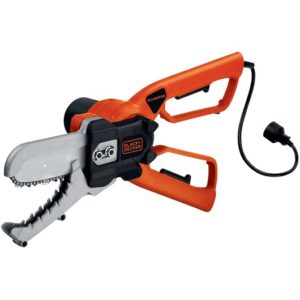
BLACK+DECKER LP1000 4.5-Amp Corded Electric Alligator Lopper Chainsaw

BLACK+DECKER LP1000 4.5-Amp Corded Electric Alligator Lopper Chainsaw
Additional Resources
Makita UC4051A 14.5-Amp 16″ Electric Corded Chainsaw
Designed for gas-free maintenance and efficient operation, the Makita UC4051A 16-Inch Electric Corded Chainsaw has a staggering chain speed of 2,900 feet per minute (FPM) for trimming and cutting.
| Specification | Value |
|---|---|
| Power Type | Electric |
| Cord Type | Corded |
| Bar/Chain Length | 16″ |
| Weight | 12.3 lbs. |
| Certifications | UL Listed |
| Warranty | 1-year |
Its motor comes with the following:
- A built-in current limiter that protects the motor by reducing power when the saw is overloaded
- An electric chain brake for optimal productivity
Other standout features include:
- An automatic oiler for heavy-duty continuous cutting
- A large oil reservoir with a view window that lets you check the oil level
- A large trigger switch with a soft start
- Ergonomic rubberized grip handles
- Tool-less chain and blade adjustments for easy maintenance
Here’s a breakdown of the pros and cons of this product:
Pros
- Chain speed of 2,900 FPM for fast cutting
- Automatic oiling system for continuous cutting
- Zero fossil fuel emissions
- Trigger switch with soft start
- Current limiter protects the motor from overheating
- Ergonomic grip handles
Cons
- Chain is loose
- Hard to assemble
- Breaks easily
- Leaks bar oil
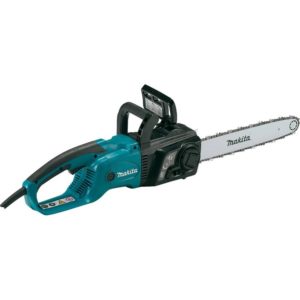
Makita UC4051A 14.5-Amp 16″ Electric Corded Chainsaw

Makita UC4051A 14.5-Amp 16″ Electric Corded Chainsaw
Additional Resources
Sun Joe SWJ807E 8.0-Amp 10″ Electric Corded Chainsaw
The Sun Joe SWJ807E 10-Inch 8.0 Amp Electric Corded Chainsaw takes the difficulty and frustration out of trimming trees. Stand on solid ground and adjust the telescoping pole to get up to 15 feet of overhead reach. Once the limbs are down, you can convert this beast into a hand-held chainsaw.
| Specification | Value |
|---|---|
| Power Type | Electric |
| Cord Type | Corded |
| Bar/Chain Length | 10″ |
| Weight | 12 lbs. |
| Extra Features | 2 tools in 1: pole chainsaw or chainsaw |
| Certifications | CSA Listed, ETL Listed |
| Warranty | 2-years |
This model’s 8-amp engine can cut tree branches up to 9.5″ thick.
Other features include:
- 10-inch Sun Joe chain and bar with an auto-oiling system
- Built-in safety switch to prevent accidental starting
Purchasing this model will give you:
- A Sun Joe SWJ807E 10-Inch 8.0 Amp Electric Corded Chainsaw
- A telescopic pole
- An oil tank
- A blade sheath
- A hex key wrench/blade screwdriver
Here’s a summary of this product’s reviews:
Pros
- 2 tools in 1: chainsaw and pole chainsaw
- Robust 8-amp motor
- Budget-friendly
- Can cut tree branches up to 9.5″ thick
- Automatic lubrication
- Telescoping pole extends to 8.8 feet for up to 15 feet of overhead reach
Cons
- Unsafe design — uses cheap plastic
- Chain tension screw often fails
- Pole doesn’t extend as advertised
- Leaks bar oil
- Confusing assembly instructions
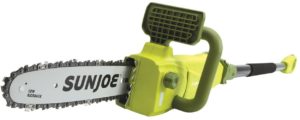
Sun Joe SWJ807E 8.0-Amp 10″ Electric Corded Chainsaw
Additional Resources
Which Corded Electric Chainsaw Is Right for You?
Corded electric chainsaws provide many advantages over gas and cordless electric models. For starters, they’re more powerful than their cordless cousins. They’re also more eco-friendly, less smelly, less noisy, and more budget-friendly than gas-powered models.
However, that doesn’t mean every corded electric saw is right for you. Depending on your preferences, goals, and budget, some choices are better than others. Here’s what you should consider before buying the best corded electric chainsaw for your project.
Bar Length
The longer the bar length, the more it can cut. The general rule of thumb is to get a saw with a bar size at least two inches larger than the material you want to cut. For example, if you’re going to cut 10″ thick tree branches, you should get a saw with a 12″ bar.
However, bigger isn’t always better. If you’re a typical homeowner or DIYer, you should get a chainsaw with a bar between 16″–20”. Chainsaws with bars over 20″ are typically meant for industrial applications. As such, they tend to be more expensive and harder to operate, particularly if you have limited experience. Saws with bars over 20″ also tend to be gas-powered.
Amps
Your saw’s amp rating indicates how much electrical current the motor can carry without degrading the insulation and the mother’s other electrical parts. In other words, this rating measures how well the motor can cool itself. The higher the amp rating, the longer a motor can run without overheating.
Consider getting a saw with a high amp rating if you plan to cut continuously for over half an hour.
Automatic Bar Lubrication System
Another feature you should consider before buying a saw is whether your model has an automatic bar lubrication system.
Lubricating your chainsaw’s bar is vital to its performance. Without constant lubrication, your chainsaw will break from the continuous friction between the bar and the chain.
Traditionally, chainsaw users were required to lubricate their saws with oil manually. However, many saws now have oiling systems that automatically lubricate the bar. Many users prefer saws with lubrication systems because:
- They always use the right amount of oil.
- They’re convenient. The system automatically applies lubricant, so you don’t have to create a lubrication schedule.
Current Limiter
Some corded electric models have in-built current limiters that protect the motor from burnout. An example is the Makita UC4051A 16-Inch Electric Corded Chainsaw. Every time the chainsaw is overloaded, the Makita UC4051A 16-Inch Electric Corded Chainsaw will instantly use its current limiter to reduce power, extending the saw’s longevity.
Chain Break
One of the most critical safety features to look for is a chain brake. This feature stops the chain from moving in the event of a kickback during operation. The chain brake activates when the front handguard moves rapidly towards you.
Tool-Less Tensioning
Some models provide tool-less tensioning, allowing you to tighten the chain without a screwdriver or multitool. This feature can be helpful when you don’t have time to get tools from your toolbox, garage, or truck.
Anti-Vibration
If you’re planning to use your chainsaw for long periods of time, consider getting a model with ergonomic rubberized handles and anti-vibration technology. These features will:
- Minimize the moving parts of the engine
- Make it easier for you to hold the saw
- Give you more control over the saw’s movements
Unique Features
Some corded electric chainsaws have unique features that make it easier to perform certain tasks.
For instance, you can use the BLACK+DECKER LP1000 4.5-Amp Corded Electric Alligator® Lopper Chainsaw’s clamping jaws to grab and cut branches in hard-to-reach areas.
Similarly, the Sun Joe SWJ807E 10-Inch 8.0 Amp Electric Corded Chainsaw simplifies the tree trimming process by giving you a telescoping pole for overhead reach. After the limbs have been cut down, you can convert the tool into a hand-held chainsaw.
Handle Position
Look at the location of your saw’s handle. Is it at the top or the rear?
Top-handle saws tend to be lighter and can usually be used with one hand. However, they’re designed to be used at height, so they’re not the best pick if your project is close to the ground.
Get a rear-handle model if you’re working with logs or branches on the ground. These models are easier to maneuver at lower altitudes and offer wider handgrips for optimal kickback protection.
Brushed or Brushless Motor
You should also consider whether your saw has a brushed or brushless motor.
As their name suggests, brushless motors don’t use carbon brushes to transmit electricity. Instead, they use magnets to transfer energy, losing less power to friction. As a result, saws with brushless motors are quieter, more reliable, and more energy-efficient than those with brushed motors.
Contact the manufacturer if you’re not sure what kind of motor a product has.
Personal Preferences
Finally, you need to think about your personal preferences. Ask yourself the following questions:
What Do I Want to Achieve?
What kind of projects are you going to be using your chainsaw for? Make a list of the projects you want to work on. Then, think about projects you may want to tackle in the future.
What Chainsaw Features Do I Want?
Next, think about the chainsaw features you want. Which features will empower you to tackle your projects with ease? For example, if you need to cut branches seven feet above you, you may want to get a chainsaw with a telescoping pole, like the Sun Joe SWJ807E 10-Inch 8.0 Amp Electric Corded Chainsaw.
Once you’ve made a list of the features you want, read through our guide again and note each product’s pros and cons. Then, make a chart of required versus “nice-to-have” features.
Here’s an example:
| Required Features | "Nice-to-Have" Features |
|---|---|
| Telescoping pole | Automatic bar lubrication system |
| Bar length must be over 10" | Anti-vibration |
| Top handle | |
| Current limiter | |
| Brushless motor |
What Is My Budget?
After creating the list, look at your budget.
If you have a limited budget, get a corded electric saw with all of your required features. But if you want some or all of the “nice-to-have” features and have the budget for it, buy a saw that also checks off the features on the list.
FAQs
It depends on what you’re looking for.
If you don’t need a high-powered saw and you value the ability to work in tight spaces, consider getting a cordless battery-powered chainsaw. However, if you value power and reliability above other factors, a corded electric saw may be better. Corded electric chainsaws don’t require recharging and can cut as long as they’re connected to an outlet.
Other differences between corded versus cordless chainsaws include:
•Corded chainsaws tend to be more affordable.
•Cordless chainsaws are less likely to create hazards since they don’t have cords.
•Most corded models are low-noise electric chainsaws.
If your corded electric saw isn’t working, ask yourself the following questions:
•Is the extension cord plugged in properly? Check if the extension cord is connected to the saw and the outlet. You should also check whether the cord is in good condition. Replace it if it’s frayed or damaged.
•Did you press the throttle lockout? Remember to press and hold lockout before pressing throttle control.
•Did the GFCI in the outlet trip? Press the button on the wall outlet to reset the GFCI. Try using another outlet if you don’t have a button or the button doesn’t work.
•Is the saw damaged? If you suspect damage, contact the manufacturer’s customer service department. Depending on the saw’s warranty, you may be able to get free repairs.
Consider using protective sleeves to organize and protect cords. These handy cases will make your cords stay in place as you cut. They can also stop cords from getting tangled and prevent trip-and-fall accidents.
Yes, you can use a corded chainsaw for bigger projects like cutting down trees, as long as:
•You’re only cutting a maximum of 10 trees per day
•The trees are 4″ to 16″ thick
•You’re only cutting for 30 to 40 minutes
If you want to cut over 10 trees with diameters over 16″, buy a gas-powered chainsaw. Gas saws are still the best pick for heavy-duty applications like timber production, heavy storm cleanup, and logging.
Corded electric chainsaws can pack quite a punch. Depending on the model and brand, a corded electric saw can be as powerful as a light-duty gas saw.
A typical corded saw should last up to 10 years with proper maintenance.
